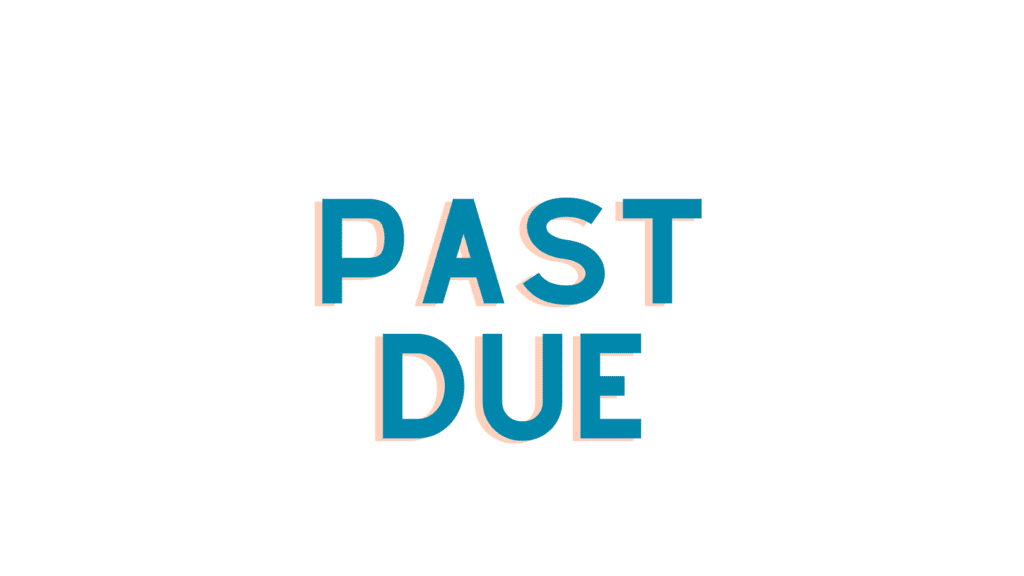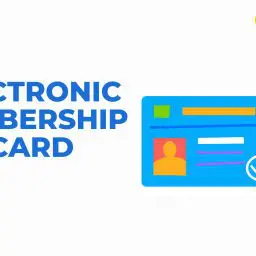Last Updated: September 28, 2023
Membership dues madness! 😂
Have you ever thought about how organizations operate and keep doing what they do, whether they are clubs, associations, or professional associations? 🤔
The question goes beyond the simple details of events and meetings; it also has to do with the money that these organizations need to run.
This financial foundation is often rooted in the concept of membership dues. In this discussion, we will delve into the concept of membership dues and explore their critical importance.
Managing membership dues well is important for the health and success of any organization, even if it seems like a simple thing to do.
📚 Why You Should Read This? 📚
Curious about what membership dues is? We’ll decode their secrets, explaining how and why they’re used, so you can make the most of them.
We are ready to expose you to everything you wonder about in the membership related dues, please keep scrolling!
🔑 Key Points We’ll Explore:
- What Are Membership Dues or Member Fees?
- What’s the Purpose of Membership Dues?
- The Importance of Membership Dues
- Annual Member Dues vs Monthly Member Dues – Pros and Cons
- Choosing the Right Membership Due Model
- How to Ask an Organization Member to Pay a Member Fee or Membership Due
- Example of Membership Due Letter
- How To Collect and Keep Track of Membership Dues
- Raklet Membership Management Software
- How to increase your membership dues
- Why membership dues are also important to other organizations?
- 7 Tips for Communicating a Member Dues Increase
Significance of Managing Dues Effectively for Organizations
Managing membership dues well is important for more reasons than just the finances involved.
It looks at how well an organization is doing financially, how well it serves its members, and how long it can stay in business.
Here are the significance of membership dues:
- Financial Stability: When membership dues are managed well, they provide organizations with a steady and stable source of income. This kind of financial security is important for paying for things like rent, bills, salaries, and making new programs.
- Resource Allocation: When organizations handle their dues properly, they can carefully assign their resources. They can put money into new projects, make services better, and plan for long-term growth, all of which help them be successful overall.
- Member Services: Dues allow organizations to give their members useful services and perks. This includes planning classes, events, publications, and other things that make the members’ experience better and show appreciation for their efforts.
- Sustainability: Organizations can make sure they will be around for a long time by handling their dues well. This means that they can keep running, growing, and fulfilling their goals year after year without having to worry about their finances or going out of business.
- Compliance and Accountability: Clear accounting and financial reports are important parts of managing dues correctly. This builds trust among members and shows that the organization is responsible, both of which are important for keeping a strong membership base.
- Planning and Budgeting: Dues are used to make budgets and plans for money. When organizations know how much money they make from dues, they can set reasonable financial goals, make smart choices, and adjust to new situations.
- Member Retention: Good handling of dues can help members stay with the organization. They are more likely to repeat their membership and stay involved with the organization if they see that their dues are being used wisely and effectively.
- Adaptability: When the economy is unclear or when problems come up out of the blue, communities that have well-managed dues have more freedom to change and weather financial storms, which lowers the chance that their activities will be interrupted.
What Are Membership Dues or Member Fees?

Are you still wondering what membership dues is? 🤔
Membership fees, also known as membership dues, are the money that people or businesses must pay to join and stay a member of an organization, club, association, or organization.
These fees are an important part of the membership structure and are used for many things.
Here’s a more concise explanation:
Entry Requirement: You have to pay membership dues before you can join an organization. They show that you are committed to the organization’s goals and actions.
Financial Support: Dues give the organization a steady stream of money. The money from this sale pays for things like rent, staff, and event costs.
Variety of Structures: Dues can be set at a specific amount each year or scaled up or down depending on things like income or participation level.
Benefits: In exchange for their dues, members usually get rewards or special rights, like access to special events, tools, or savings.
Renewal: Members often have to pay dues on a monthly basis to keep their membership active. This helps organizations keep their member lists up to date and get ongoing support.
What’s the Purpose of Membership Dues?

Membership dues serve as the lifeblood of many organizations, enabling them to function, provide services, and thrive.
They play a critical role in supporting the organization’s mission, maintaining financial stability, and delivering valuable benefits to members.
Purpose #1: Financial Support
Membership dues are an important source of money for groups that need to meet their costs and keep their activities going.
Purpose #2: Resource Allocation
When people pay dues, organizations can use the money they get to plan events, create new programs, and do other things that help their members.
Purpose #3: Member Benefits
Most dues come with perks like access to special events, tools, and chances to network, which makes membership more valuable.
Purpose #4: Sustainability
Managing dues well ensures the organization’s long-term success, so it can continue to help its members and carry out its purpose.
The Importance of Membership Dues
Membership tiers are the most important thing for groups, including nonprofit organization, because they are a key part of their financial stability, program development, resource allocation, and long-term planning.
These dues give organizations a consistent and secure source of income that helps them keep running, grow their programs, and give their members good services.
By collecting member dues, groups can make good use of their resources and improve the membership experience as a whole.
Let’s review the importance of membership dues:
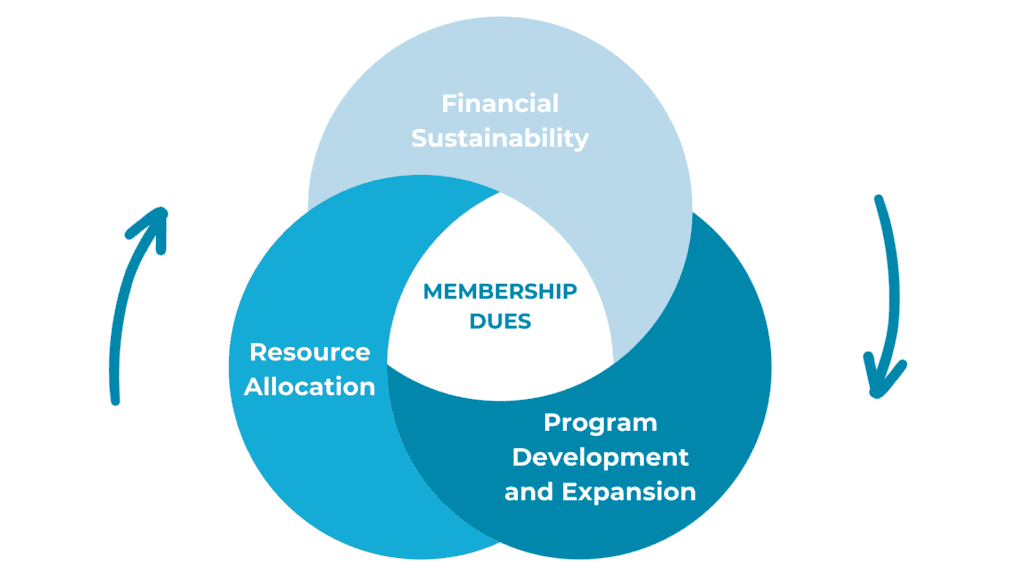
- Financial Sustainability: Member dues make sure that organizations have a steady and predictable source of income.
This money helps them pay for running costs, keep infrastructure in good shape, and spend on their ongoing projects.
It gives the group the money it needs to run its day-to-day business and keep its finances in good shape.
- Program Development and Expansion: Membership dues help groups develop and grow their programs, services, and initiatives.
With a steady source of income, they can put money into new projects, research, training programs, lobbying efforts, and reaching out to the community.
Dues are a key part of funding new ideas, meeting the needs of members, and growing the group.
- Resource Allocation: Collecting member dues lets groups decide how to use their resources to help their members.
These tools can include access to member-only resources, chances to network, educational programs, and services that are only available to members.
Dues assure that organizations can give their members valuable benefits and custom experiences, which increase the total value of being a member.
Annual Member Dues vs Monthly Member Dues – Pros and Cons
Organizations can set up member dues so that they are paid either once a annual membership or monthly membership. Each way has its own good points and bad points.
Let’s take a look at the pros and cons of both annual membership dues and monthly membership dues:
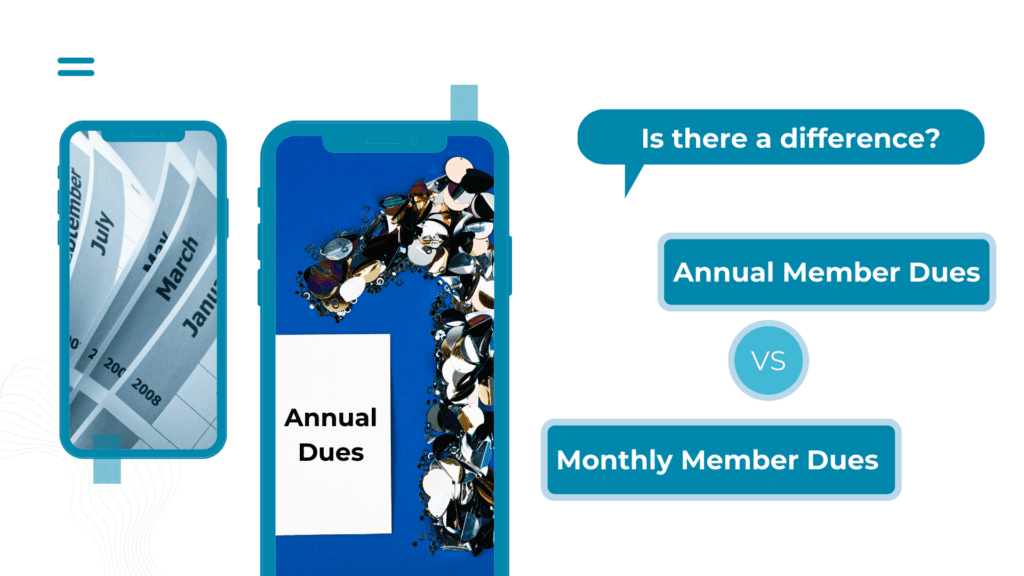
Annual Member Dues:
Pros:
✅ Steady Revenue Stream: Annual dues or other named which is one year membership gives the group a big sum of money up front, which helps keep its finances stable for the year.
✅ Administrative Efficiency: Only collecting dues once a year cuts down on the work that needs to be done to keep track of bills and recalls.
✅ Member Commitment: Members who promise to pay their dues every year may show that they care more about the group and its purpose.
✅ Budgeting Simplicity: The group can make its yearly spending plan when it knows exactly how much money it will get from dues.
Cons:
❌ Financial Burden: For some members, paying a bigger amount up front can be too expensive, which could make them less likely to stay with the group.
❌ Risk of Non-Payment: Some members may forget or keep putting off paying their yearly dues, which could cause problems with cash flow.
Monthly Member Dues:
Pros:
✅ Affordability: The monthly revenue are often easier for members to pay because the cost is spread out over time.
✅ Stable Cash Flow: Making payments every month ensures a steady flow of cash throughout the year, which helps with budgeting and keeping your finances stable.
✅ Member Retention: Members may stay with the group longer if they don’t have to worry about money as much. This is because it’s easier for members to prepare for smaller monthly payments.
✅ Accessibility: Because the dues are paid every month, it’s easier for more people who might not be able to pay the yearly fee to join.
Cons:
❌ Administrative Overhead: Keeping track of monthly payments can be a lot of work for the office, as it requires notes, billing systems, and help for members when things go wrong, like when payments don’t go through.
❌ Budgeting Complexity: Because of the fluctuating income each month, monthly dues can make spending harder.
❌ Lower Initial Revenue: Compared to a yearly dues plan, organizations may start out with less money to work with.
Choosing the Right Membership Due Model

Any organization has to make a very important choice about their membership dues model because it can have a big effect on their general success, ability to stay financially stable, and ability to keep members.
💡 Tip: If you want your group to be successful in the long run, you need to evaluate it often and be willing to change how you do things.
To help you make an informed choice, here are some steps and things to think about:
Understand Your Organization’s Needs and Goals:
- Make your organization’s purpose and goals more clear.
- Figure out how much money you need for things like running costs, program creation, and plans for growth.
Know Your Membership Base:
- Look at the demographics of your present and future members.
- Think about the cash situations, tastes, and aspirations of your members.
Evaluate the Pros and Cons:
- Think about the pros and cons of paying dues once a year versus once a month.
- Think about how the goals and wants of your group and its people fit with each model.
Member Feedback:
- To find out what your current members want, use polls, focus groups, or feedback forms to get their opinions.
- To get feedback, you might want to try out or run test projects for each of the dues models.
Budget and Cash Flow Analysis:
- Make financial forecasts for both dues models that take into account cash flow, costs, and income.
- Think about how each model will affect your ability to pay your bills and put money into member services.
Flexibility and Options:
- You could offer different ways for members to pay their dues, like yearly, weekly, or even tiered prices, to meet their needs and budgets.
Testing and Monitoring:
- If you can, try out both dues models for a set amount of time to see how members react, how many stay, and how much money they bring in.
- Keep an eye on and rate the chosen model’s success all the time.
Legal and Regulatory Considerations:
- Making sure that the dues plan you choose follows all the rules and laws in your area is very important.
Review and Adapt:
- Check back in on your chosen dues model every so often to see how well it works and how well it fits your organization’s changing needs.
How to Ask an Organization Member to Pay a Member Fee or Membership Due

Don’t you know how to collect membership dues from your members?
Don’t worry, we’ve got you covered.
Here’s a step-by-step guide on how to ask members to pay their dues:
- Personalized Outreach: If at all possible, try to make contact with members on an individual or small group basis. Personalize your message to highlight specific benefits or tools for each member. This shows that you care about them as a member and understand what makes them special.
- Clearly State the Amount: Get the exact amount of your membership cost and tell your audience. Make the member aware of their financial responsibility by being honest about the price.
- Specify the Due Date: The due date must be specified in no uncertain terms. In order to encourage quick payment, it is helpful to specify a due date.
- Specify Payment Methods: Clearly state the methods of payment that are acceptable, such as electronic payment portals, paper checks, or anything else. Provide your members with the resources they need to make payments online, including links, instructions, and points of contact.
- Show Appreciation: Thank the member for their prior help and for their continued dedication. Give them the impression that their support is crucial to keeping the organization going.
- Offer Help: Make sure members know they may reach out to you if they have any issues with making a payment. Give them a way to get in touch with you if they have questions or need help. This might be anything from an email address to a phone number.
Example of Membership Due Letter
If you still don’t understand how to ask for membership fee from your member, here is the opportunity for you!
Sometimes members may forget to pay monthly or annual fees, there are technical problems, or dues need to be increased.
We have prepared three different examples of membership due letters that you can use in such cases.
Example Letter 1
In the first example, we’ve made a template for a letter to send to a member whose monthly payment has been late.
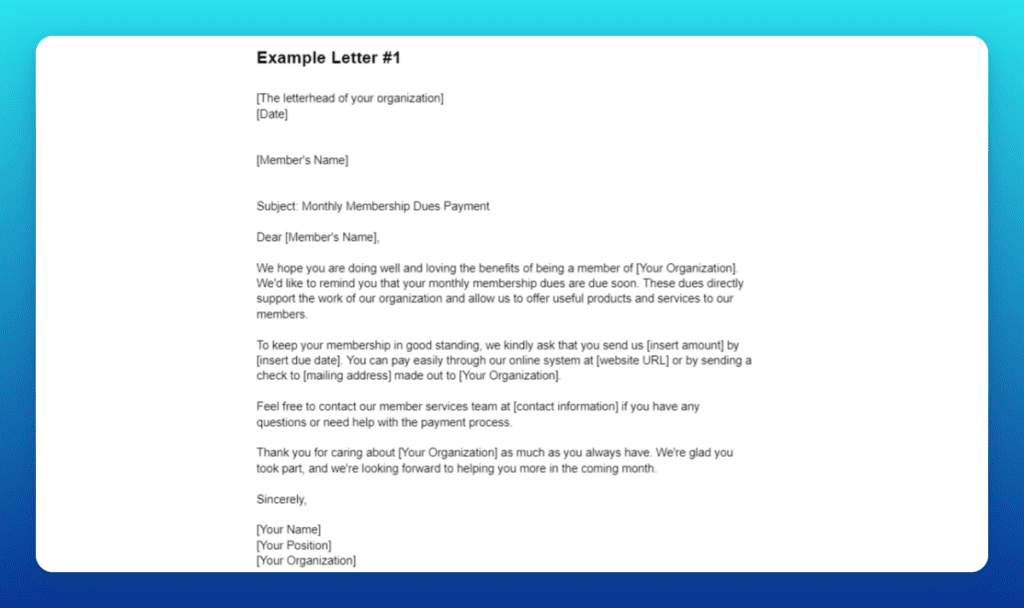
Example Letter 2
In our second example, you see a letter with an annual payment reminder. You can use it in payment cases that are not yet due but will be soon and help your members renew their membership.
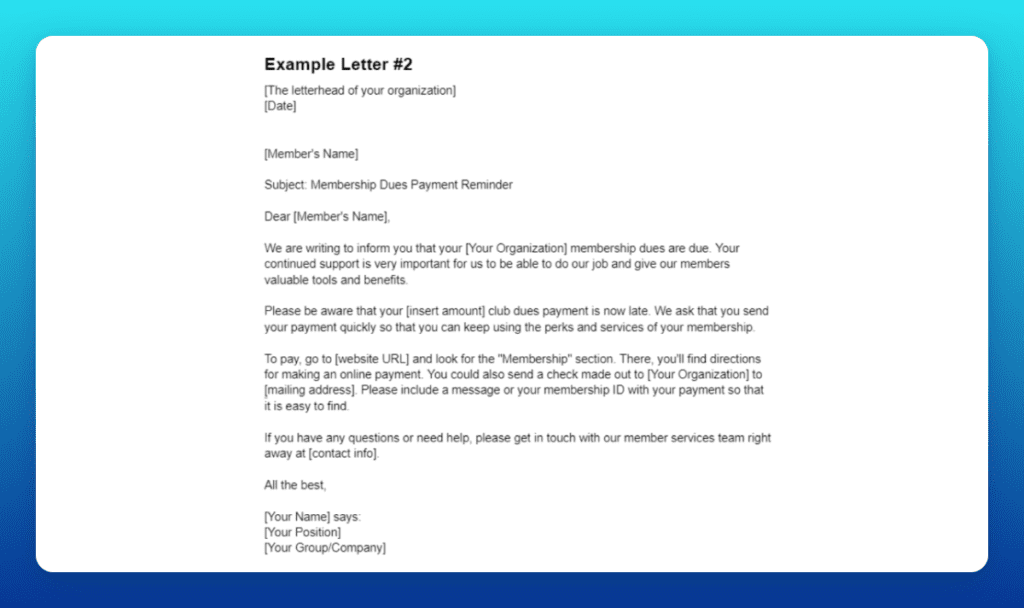
Example Letter 3
Our third example is a membership dues increase letter. We prepared a letter to be sent after an increase in membership dues. You must send a notice letter to your members. Do not forget to explain your reasons in this letter.
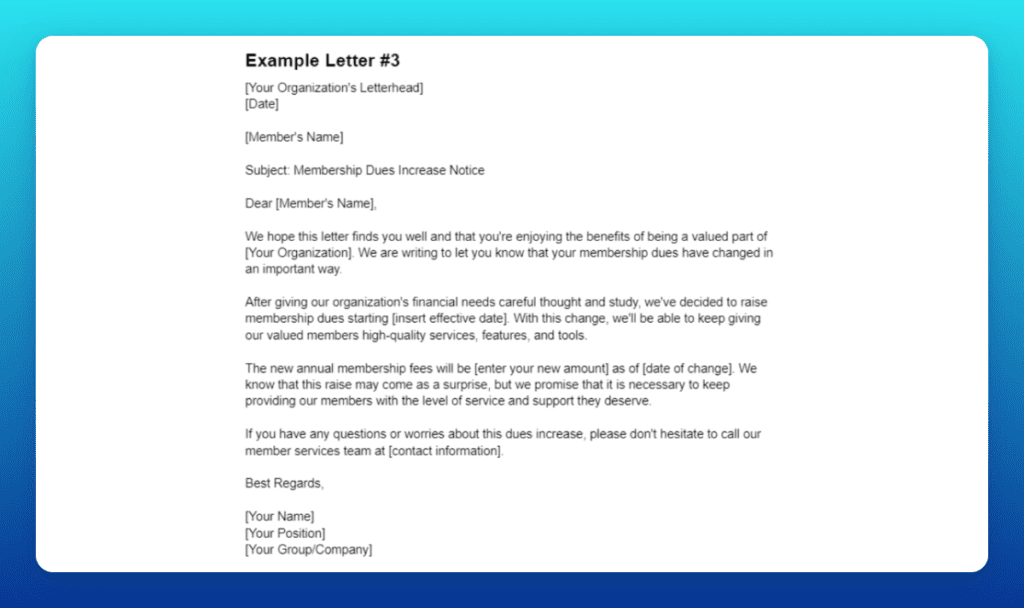
How To Collect and Keep Track of Membership Dues

It is very important for the financial and operational stability of the organization that you collect and keep correct records of membership dues.
So, managing membership dues well means setting up clear ways for members to pay, using technology to make things easier, keeping accurate records, and communicating with and helping members well.
By using these methods, groups can make sure that collecting dues goes smoothly, keep their finances stable, and build good relationships with their members.
In short:
- Set up clear payment procedures
- Assign timely reminders
- Offer different payment plans
- Use software for managing memberships
- Maintain accurate records
- Track delinquent accounts
- Tell your community to changes
- Be open and support
Raklet Membership Management Software
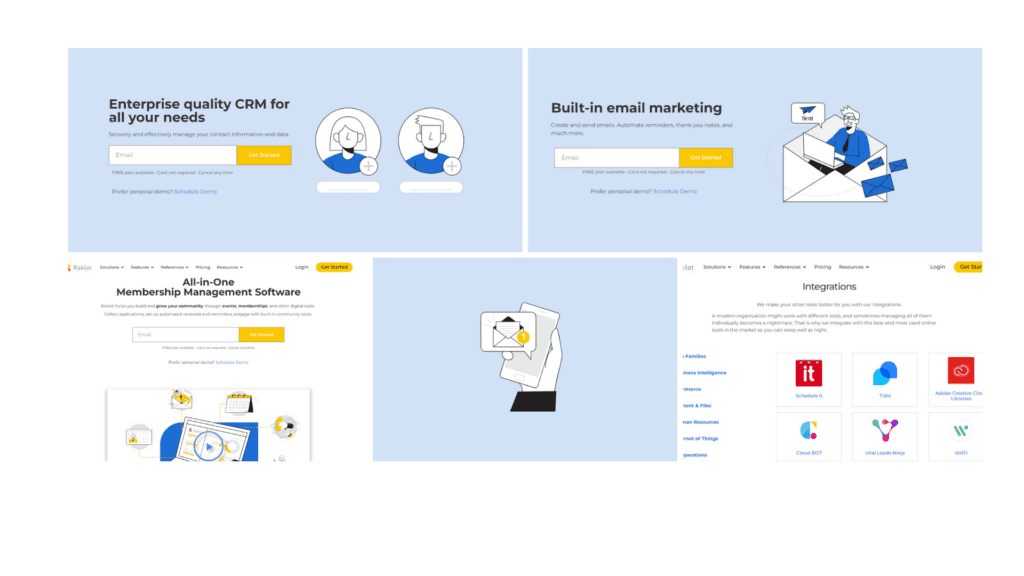
Raklet is a membership management software platform that offers a range of features designed to streamline the process of collecting membership fees, managing subscriptions, and handling various aspects of membership administration.
Here are some of the key benefits of using Raklet for membership fees and subscriptions:
Easy Fee Collection
Raklet provides a user-friendly online payment system, making it simple for members to pay their dues and fees electronically. This minimizes the administrative burden of handling cash or checks.
Recurring Payments
The platform supports recurring payments, allowing members to set up automatic monthly, quarterly, or annual payments for their subscriptions. This ensures a steady and predictable income stream for the organization.
Automated Reminders
Raklet can send automated email reminders to members about upcoming dues payments, reducing the chances of missed payments and enhancing collection rates.
Member Engagement
Beyond fee collection, Raklet offers tools for member engagement, including event management, communication features, and networking opportunities, all of which can help retain and attract members.
Communication Tools
Raklet’s communication tools, discussion board, email campaigns, and SMS messaging, make it easier to keep members informed about fee deadlines, events, and other important updates.
Raklet can integrate with other software and applications you may already be using, such as accounting software or email marketing platforms, to streamline your workflow.
Membership Directory
The platform includes a membership directory that allows members to connect with each other, fostering a sense of community and networking.
Support and Training
Raklet offers customer support and training resources to help organizations make the most of its features and functionalities.
How to Increase Your Membership Dues

Increasing membership dues is a smart move that organizations, even membership dues for nonprofits, may want to think about if they want to stay in business and meet their financial goals. Here are some ways to improve your membership dues effectively:
- Evaluate Financial Needs: Figure out how much money your group needs and if you need to raise membership dues. Think about things like rising expenses, inflation, or more services that might make the change necessary.
- Communicate the Benefits: Make sure your current and future members understand the benefits of membership. Show how their support helps, what products or services they get access to, and how their higher dues will help the group reach its goals or mission.
- Market Research: Find similar groups and look at how their membership fees are set up. Examine the standards and benchmarks in your industry to make sure that your suggested increase is still competitive and reflects the unique value that your business offers.
- Develop a Membership Dues Increase Letter: Make a well-written letter about the rise in membership dues that explains why the change is being made. Include information about what will happen to the group and how the higher dues will help members get better services or benefits.
- Personalize Communication: Personalize your letter about raising membership dues so that it speaks to each member by name. This shows that you appreciate their support and participation. Personalization can show members that the change isn’t random and remind them how important they are to the group.
- Provide Options: Give members ways to deal with the raise, like letting them choose between annual or monthly membership fees. Consider giving incentives, like discounts for paying early, exclusive admission to events, or extra benefits, to ease any initial opposition to the dues increase.
- Provide Help and Support: Some members may have trouble as a result of the higher dues. Offer help and support choices like financial aid or payment plans to make sure everyone can join and help members who need it keep their membership.
Why Membership Dues Are Also Important to Nonprofits, Associations, Chambers and Other Organizations?
As we mentioned before, membership dues are the lifeblood of nonprofit organizations, associations, chambers, and similar entities.
They not only ensure the financial sustainability of these organizations but also enable them to fulfill their missions, support their members, and provide valuable benefits and resources to their respective communities.
Here are several compelling reasons:
Financial Stability: Membership fees are a steady and stable source of income that helps these groups pay for their programs, initiatives, and running costs. They need to be financially stable in order to run their day-to-day business and stay in business in the long term.
Program Development: Membership fees help groups improve and add to their services and programs, which are usually meant to help members reach their goals. This includes teaching events, lobbying, reaching out to the community, and more.
Advocacy and Representation: Many organizations speak up for the interests of their members. Membership fees enable organizations to successfully advocate for the needs of their members before governmental bodies, regulatory agencies, or other stakeholders.
Networking and Resources: Many organizations and associations help their members network, share information, and get access to resources. Dues help the group put together and host these kinds of events and projects.
Building Community: Organizations and nonprofits often help their members feel like they are part of a community. Dues help build communities by giving users a safe place to meet new people, work together, and talk about their experiences.
7 Tips for Communicating a Member Dues Increase
As an organization, it’s important to talk about this with honesty, clarity, and compassion if you want to keep a positive connection with your members.
In this part, we’ll give you seven important tips for telling members that their dues are going up.
By using these tips, you can handle this tricky process well and make sure that your members understand why the dues increase and continue to support the goals of your organization.
Tip 1: Provide Clear Explanation
Members should know why their dues are going up before they have to pay more. Here is where you should start to explain why the price increased. Members are more likely to agree to a fee increase if they know why it’s happening.

Tip 2: Highlight the Benefits
Remind your members what features you offer with increasing dues. If there are newly added features, don’t forget to mention them. In this way, you can prevent them from reacting to increasing dues.
Tip 3: Early Communication
Make sure your members know as soon as possible that the dues will be going up. This gives them the chance to change their spending plans if they need to, and it also shows that you care about their time and money.

Tip 4: Be transparent
Tell us about your company’s cash situation. Members like honesty, so if they knew why the price went up, it might make it easier for them to accept it. But you should be careful about giving information that is especially sensitive.
Tip 5: Open Dialogue
Make sure that users have a way to ask questions and complain about the dues increase. There may be a place for comments, an online forum, or a particular email address on the notice itself. Being open to the discussion shows that you value the views of the people in your group.
Tip 6: Gradually Increase
If the increase is large, members can be more ready for it if it happens gradually. This can be less of a financial problem for your members and show that your organization cares about their financial situations.

Tip 7: Show Appreciation
You should be sure to thank your members for their continued support. Make sure they know how important they are to your organization.
Last Chapter!
It’s time to part.
We’re just kidding 😂, but we are happy to say that you have come to the end of this blog post.
We hope you found every detail you were looking for.
Let’s see what we talked about briefly, shall we? ✨
Membership dues are a fundamental aspect of the financial foundation for organizations, ranging from clubs and associations to nonprofit entities.
The importance of managing these dues effectively cannot be overstated, as they contribute to the organization’s financial stability, resource allocation, member services, sustainability, compliance, planning, member retention, and adaptability.
Organizations must handle dues well to not only meet their financial needs but also provide value to their members.
Raklet membership management software can provide numerous benefits, including easy fee collection, recurring payments, automated reminders, member engagement tools, communication features, integration capabilities, and more, making it a valuable tool for organizations while collecting membership dues.
In essence, membership dues are not just about collecting money; they are about sustaining the organization, serving the members, and fulfilling the organization’s mission.
FAQs About Membership Dues
1-What Are Membership Dues?
Membership dues are the prices that people or companies pay to join and stay a part of a club, association, group, or organization. These fees help pay for the group’s services and events.
2-Why Do I Need to Pay Membership Dues?
Dues from members are necessary for the group to stay financially stable. They help pay for the organization’s running costs, events, and member perks, which makes sure it can do its job.
3-How Can I Pay My Membership Dues?
There are many ways to pay, but some of the most common ones are web payments, checks, and electronic transfers. Usually, the organization gives clear directions on how to pay.
4-Are Membership Dues Tax Deductible?
Membership dues may be tax-deductible in some situations, but only if the group is tax-exempt and the dues are tax-deductible.
5-Can I Opt Out of Paying Membership Dues?
Most of the time, paying registration fees is required to actively participate in the organization. If you’re worried about paying your dues, you should talk to the organization’s leaders about it so they can help you find a solution.

